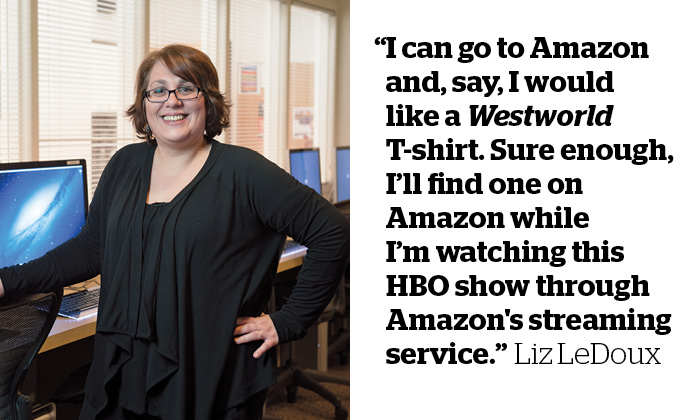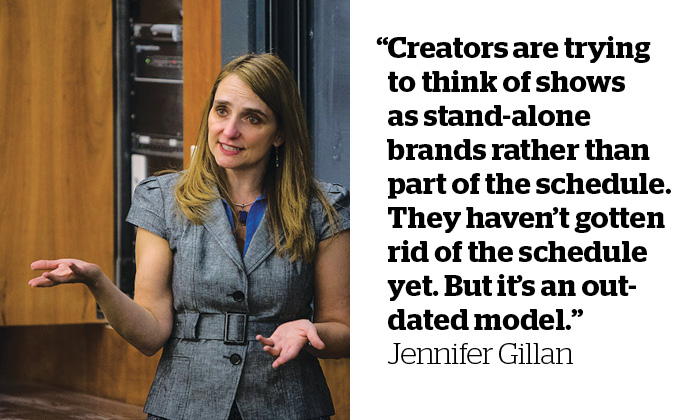
Entertainment is Everywhere
These are days of high drama in the entertainment industry. Titans like MGM are struggling to stay on their feet. Upstarts like Netflix are taking over the world. And not too long from now, you might open a different app instead of changing television channels.
You may already be doing it.
For as long as video has existed, it has been defined by the places people see it. Movies are made for cinemas and sitcoms, for televisions.
But increasingly, people are turning elsewhere for their entertainment fix. In a world where glowing rectangles are every-where, it doesn’t always make sense to take a trip to the theater ... or even the living room. Companies like NowThis and INSIDER have grown by making videos for Facebook; BuzzFeed is a juggernaut on YouTube and Snapchat; and streaming services like Netflix and Amazon Video have established their own ecosystems for creating, buying and distributing shows.
“The world of entertainment and programming is definitely, definitely changing,” says Emily Webster ’02, an L.A.-based producer whose portfolio includes MTV’s Catfish and HBO’s Emmy-nominated Project Greenlight. “I’ve noticed there are a lot more job opportunities becoming available in new media versus traditional television programming.”
Content creators — from news organizations to movie studios — are scrambling to compete for the attention of users. This has given rise to “distributed content,” so called because the video stories go directly to platforms such as Facebook, Netflix and YouTube, instead of traditional places like television and movie screens.
The new world of made-for-platform video raises all sorts of questions about the types of stories media companies should be making, and the types of stories consumers want to see. Will anyone watch a half-hour episode of Modern Family on Facebook? (No.) Will two-minute BuzzFeed Tasty videos thrive on Netflix? (Unlikely.) Should The New York Times put its documentaries on its website and charge high ad prices, or try to reach millions of viewers on Facebook? (Hard to tell.) Should HBO put commercials in its shows? (Hope not.)
The landscape is shifting fast — and with high stakes. There are opportunities for new media companies to bloom, for old media companies to adapt, for people with different kinds of talents to step in, and for someone to figure out how to make money from any of this.
REVENUE DÉJÀ VU
The main revenue strategies of new media look a lot like those of old media: advertising and subscriptions.
Take YouTube, the first major platform for video content. Like a television network, it allows content creators to show commercials before their videos.
“The more popular your content is, the more eyeballs you have, the more a particular ad is seen,” says Elizabeth LeDoux, a filmmaker and director of the Media and Culture program at Bentley. YouTube can charge a company more money to show their ads in front of more popular channels, just like a company charges more to run ads in front of particular television shows. “They know there will be more people watching, so they’re going to get more bang for their buck.”
 Similarly, there are sponsorships, whereby brands pay to have their products featured in content. It happens in traditional media — think of the product placement for Bud Light in the Transformers movies — and it’s even more essential to the way videos are funded on Facebook and YouTube.
Similarly, there are sponsorships, whereby brands pay to have their products featured in content. It happens in traditional media — think of the product placement for Bud Light in the Transformers movies — and it’s even more essential to the way videos are funded on Facebook and YouTube.
Webster notes that revenue from sponsorships can eclipse advertising revenue. It makes sense. Viewers can fast-forward through commercials or install ad-blocking software, but they will acknowledge a product that is part of a video they’re watching. The brevity of web video doesn’t allow much space for commercials, anyway.
The alumna recalls working on a show whose sponsors included a headphone company. “We had to have our lead cast member wearing these headphones in, let’s say, four out of six episodes we were delivering. And it had to be no shorter than five seconds per shot.”
Some companies produce their own content. Red Bull, for example, has an in-house documentary unit that makes movies about adventurous athletes and unusual sports — subjects that dovetail with their brand identity. Many are available on Netflix.
“It’s so subtle. You wouldn’t even know that Red Bull is producing it, except for the fact that you see their logo right before,” says Webster. “In my eyes, I have a lot more respect for that brand because they made this beautifully entertaining documentary.”
SUBSCRIBING TO THE SAME MODEL
The other main revenue source for new media is subscriptions, with Netflix the best-known example. For a few dollars a month, the company offers a huge library of videos without any advertisements. Netflix knows its users want new, high-quality shows to binge over a weekend, so they make them. It isn’t a new model, either: HBO has used a subscription model for decades. And as with HBO, anyone who wants to keep up with pop culture water-cooler conversation needs to be a Netflix subscriber.
People keep subscribing to Netflix because its shows are so acclaimed, LeDoux explains. “You get Stranger Things, House of Cards and all these other shows, so people think ‘I’d rather have a Netflix account’ than, say, Hulu or Amazon, because of the original programming.”
Amazon Video is slightly different. In addition to selling media content, it’s trying to sell you, well, pretty much everything. As long as you’re watching videos from Amazon, you’re visiting Amazon’s website and attached to Amazon’s brand. It doesn’t appeal to people just because of its programming, but because it’s an entire digital ecosystem.
“Other television stations, networks and cable channels can’t really compete,” says LeDoux. “I can go to Amazon and, say, I would like a Westworld T-shirt. Sure enough, I’ll find one on Amazon while I’m watching this HBO show through Amazon’s streaming service. I’ll receive free shipping, as well as recommendations for books and games that are connected to the show.”
WATCHING AND WAITING
With so much choice, legacy television is going through a period of disruption. One of the casualties may be the scheduling model. There was a time when people might tune into a show at 8:00 p.m. and stick with a channel until 11:00 p.m. Few people have that type of television habit anymore. In fact, making viewers wait a week to watch the latest episode risks losing their attention. Netflix now drops an entire season’s worth of episodes at once.
It’s a viewing habit that Bentley faculty member Jennifer Gillan describes in her forthcoming book, Should See TV: Television and Serial Monogamy. Instead of juggling several different shows at once, waiting a week for each episode and half-remembering the story arc, people watch one complete series at a time.
“Serial monogamy can yield different insights given that it involves immersive, undistracted viewing of all available episodes of a series, in a compressed time,” says the professor of English and media studies. Binge-watching makes pre-Netflix shows like Seinfeld or Freaks and Geeks a completely different experience. And shows made for binge-watching, like The Walking Dead and Orange is the New Black, are built with a different kind of arc in mind.
Gillan — also the author of Television and New Media: Must-Click TV and Television Brandcasting: The Return of the Content-Promotion Hybrid — says that producers have moved away from seeing shows as just programming for channels.

Considering shows as individual brands means they are less likely to be canceled, according to Gillan. The television viewership metrics matter less. Now, instead of MTV paying attention only to how many viewers Teen Wolf gets on Tuesday nights, they also look at how many people stream it on the MTV app, how many people watch it later, how many people play Teen Wolf-branded games on their site, and how many people engage with the show’s Facebook page
ALL THE WORLD’S A STAGE
Faring less well are movie theaters. Attendance in the United States has been sluggish in the past few years, according to data from the Motion Picture Association of America, Variety and other industry sources. Though movie ticket prices drove theatrical revenue up in 2016, attendance was flat from the year prior, with 1.32 billion admissions. That is only modestly better than 2014’s 1.26 billion admissions, a 20-year low.
The time between theatrical release and video-on-demand release is shrinking as well. In 2005, the average wait between a film’s release in theaters and on home video was 135 days. In 2016, it was 102. And soon — if major studios and theater chains can come to an agreement — the window may be just a couple of weeks.
As Michael Barra ’96 sees it, the changes signal a major shift in the way media companies think about distribution. Barra is president of media and entertainment for the Araca Group, which produces and distributes Broadway shows in partnership with major Hollywood studios, music publishers and game companies. He says audiences prefer consuming content in different ways. They tend to be agnostic about the platform, and prioritize convenience over most other factors.
Distributors are quickly moving to meet viewers in their place of choice. For movies, this could mean earlier availability on streaming platforms. For television shows, it could mean accessibility on apps. Where Broadway shows are concerned, Barra sees live broadcasts as a major trend. It started a few years ago, when London’s National Theatre began broadcasting shows live in movie theaters.
“At the time,” he says, “the prevailing wisdom was that any ability to see our show anywhere that is not our theaters would cannibalize our very sensitive Broadway marketplace.”
But that kind of thinking is shifting. For some of his upcoming shows — for example, stage adaptations of major properties including Clue — he is weighing different distribution methods.
“We want people to consume. We know that millennials, especially, are used to going to YouTube, doing a search and seeing whatever it is that they want to see, at whatever time. Broadway hasn’t accomplished that yet.”
For live shows, Barra foresees a model similar to stand-up comedy. An artist does a few shows, then Netflix or another service streams the show for millions of subscribers. Or, better yet, a musical might debut on Netflix or Hulu — and then turn into a live show, as happened with High School Musical on the Disney Channel in 2006.
“Musicals may actually debut on a platform, and then either skip Broadway and go to tour, or go directly to stock and amateur [licensing],” says Barra. “I can absolutely see that.”
CREATIVE LEVERAGE
One notable byproduct of the distribution revolution has been changes in how content is actually made. According to Webster, the process of creating a five-minute video for the Web looks a lot like producing a television episode — but everything is compressed.
“When I was covering New York Fashion Week for Vogue’s website, we had to shoot, edit and deliver to the site that night,” she explains. “With a television show, like Catfish, we have a couple of months to complete an episode.”
The narrative skills needed to make a short video are different from those required for a TV episode — and Webster finds the process refreshing.
“There are fewer people working on it,” she says of web videos. “Sometimes you have a little more creative leverage to do your own thing. In television, there can be a lot of cooks in the kitchen.”
TALENT UNLIMITED
Another corner of the industry that has changed is casting. La La Land-esque depictions of the hopeless odds of becoming famous will always persist, but the barriers to success have shifted. It used to be that the talent — actors, singers, dancers — needed a team of people to make their work visible in the industry.
The Internet has changed all that, says Scott Wojcik ’88, a casting director and producer who has worked on movies, commercials and web shows.
“Most actors have a website,” says the alumnus, a partner in New York-based Wojcik | Seay Casting. “Distribution is almost unlimited now with social media ... which is very exciting, because if artists are trying to tell stories, now they have more places to put those stories.”
The ability to sculpt your image online means that actors are operating in a more controlled, choreographed environment. The best casting, Wojcik says, is when the actor’s personality and craft are both present. He looks for actors who are believable and relatable, as well as “explosive” and “in-the-moment.”
“That’s what we seek out,” he says of auditions. “Whether we do it live or via videotape, and whether or not the directors are in the room.” Another constant is the mission of casting itself: finding the person with the right qualities for the job. The change is having so many more places to seek out the right people.
“There’s a subtle difference ... just more variety of styles to appreciate,” says Wojcik. “I don’t look for anything different.”
RETURN TO THE WELL
In the video-distribution shakeup, a few things have not disappeared, as you’ve probably noticed: remakes, reboots and sequels.
These are strategic choices, according to Barra. Considering the sheer volume of content available, adapting something that already exists becomes, paradoxically, a way to stand out. People are more likely to notice a brand they are already familiar with. Moreover, he adds, adaptations can be a hallmark of high quality.
“All the Golden Age Hollywood movies were based on stage plays or books,” observes Barra, whose company is producing plays inspired by Monopoly and SpongeBob. “The entire animated Disney canon is based on fairy tales or other sources.
”There’s also the difficulty of getting noticed on emerging platforms. Users typically don’t pay much attention to advertisements for shows. Instead, they discover new things to watch through word of mouth.So a story reboot, prequel or sequel has a built-in potential audience.
Amid the dizzying change in how we consume content, as old platforms evolve and new ones emerge, we can take some comfort.
The commitment now as then: tell great stories. The best ones can last for generations, inspiring hearts and creating memories that transcend any medium.

